Instinct® II and N-Serve® Research Findings
The research findings reported here were obtained from a literature review performed by Alison Eagle of Duke University (Nicholas Institute for Environmental Policy Solutions) in February 2016 under contract to the Environmental Defense Fund.
Both Instinct® II and N-Serve® (Dow AgroSciences) are sold as nitrogen stabilizers with the active ingredient nitrapyrin. The primary difference between these two products is the form of nitrapyrin used in the stabilizer. Nitrapyrin is formulated as a capsule in Instinct® II, a water-based product that mixes well with UAN solutions (32% and 28%). In this format, it can also be mixed with ammonium sulfate, liquid manure, aqua ammonia, and other liquid fertilizers containing nitrogen, phosphorus, and potassium. In N-Serve®, an oil based nitrogen stabilizer that mixes well with anhydrous ammonia, nitrapyrin is formulated as an emulsifiable concentrate. Both stabilizer products are marketed primarily for corn, sorghum, and wheat, and are advertised to increase yield, improve standibility, reduce risk of stalk rot, increase grain protein, and enhance crop drydown (The Dow Chemical Company 2012; The Dow Chemical Company 2013a; The Dow Chemical Company 2013b).
Nitrapyrin is a chlorinated pyridine compound that functions as a nitrification inhibitor. It delays the nitrification process by inhibiting the Nitrosomonas spp. bacteria that convert ammonia to nitrite, thus retaining more fertilizer-applied nitrogen in a form readily available to crops. This can prevent the loss of soil nitrogen through leaching or runoff of nitrate (NO3), or gaseous emissions of nitrogen (N2) and nitrous oxide (N2O) gases. For over 40 years, nitrapyrin has been used and studied internationally as a nitrification inhibitor with the goal of increasing crop yields and reducing the environmental impacts of nitrogen fertilizers used in agriculture.
Nitrapyrin was first identified as a nitrification inhibitor in 1962, where it was shown that nitrapyrin activity appears to select for Nitrosomonas and does not have a significant effect on other nitrifiers or soil heterotrophs (Goring 1962; Laskowski et al. 1975; Shattuck and Alexander 1963). Nitrapyrin was first registered as a product in 1974, and early laboratory studies with field soils showed that nitrapyrin restricts nitrogen loss through volatilization differently based on application method, soil type, and soil condition (McCall and Swann 1978). It was demonstrated in these early lab studies that nitrapyrin is significantly more effective at reducing volatilization losses when incorporated into the soil (Briggs 1975), and Dow AgroSciences emphasizes the importance of this application method in their product literature.
Later lab studies indicated that nitrapyrin could also reduce N losses from NO3 leaching by an average of around 11% (Owens 1981; Timmons 1984). These observations were also seen in field lysimeter studies with corn with average NO3 leaching loss reductions ranging from 7 to 28% over 3 and 6-year periods, respectively (Owens 1987; Timmons 1984). Other early studies of nitrapyrin in the field clearly demonstrated nitrapyrin’s ability to conserve soil N under certain conditions (Nelson and Huber 1980).
A search of the scientific literature and grey literature (conference proceedings etc.) was conducted to locate data on crop yield responses for nitrapyrin. Data were incorporated into an existing database on fertilizer management field trials, including all available management, climate, soil, N loss, and crop productivity information.
The following tables summarize the yield impacts of nitrapyrin with discussion below each table. Weighted averages are calculated where possible, with results from each study weighted by the inverse of the number of trials in each location. This prevents studies from very well-studied locations from overwhelming the average results.
Overall effect sizes are reported for all studies, and also restricted to peer-reviewed data and separated out by specific products, as applicable. All experiments included in these tables either reported using N-Serve® or did not indicate any brand-name for the nitrapyrin used..
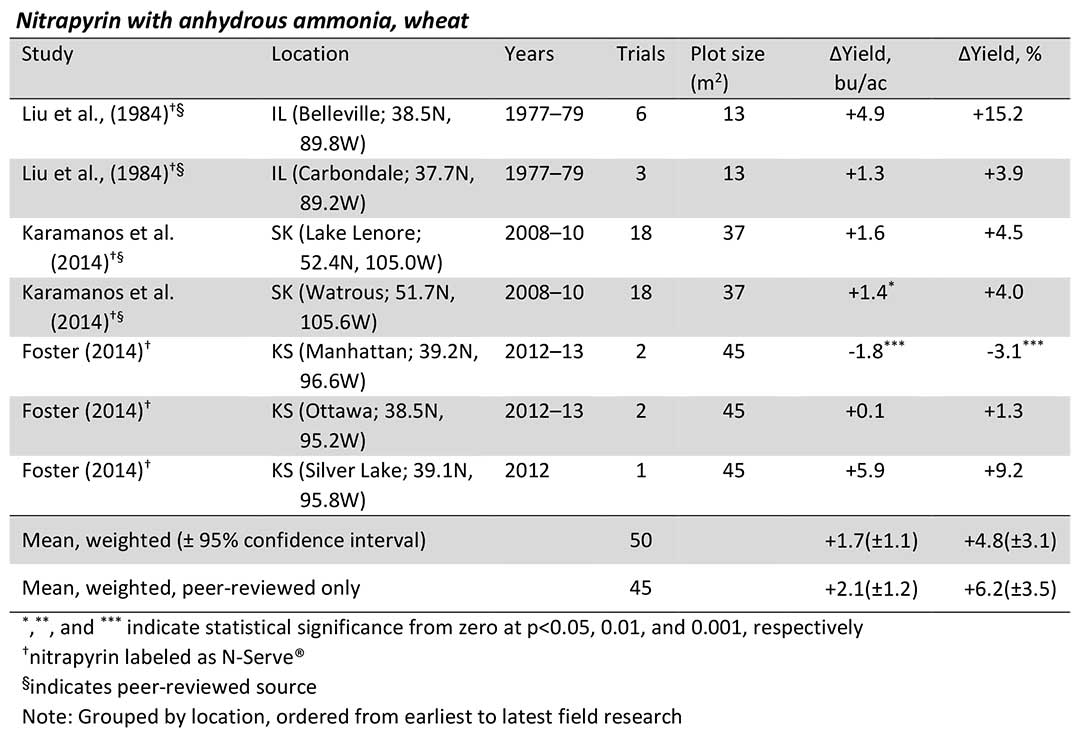
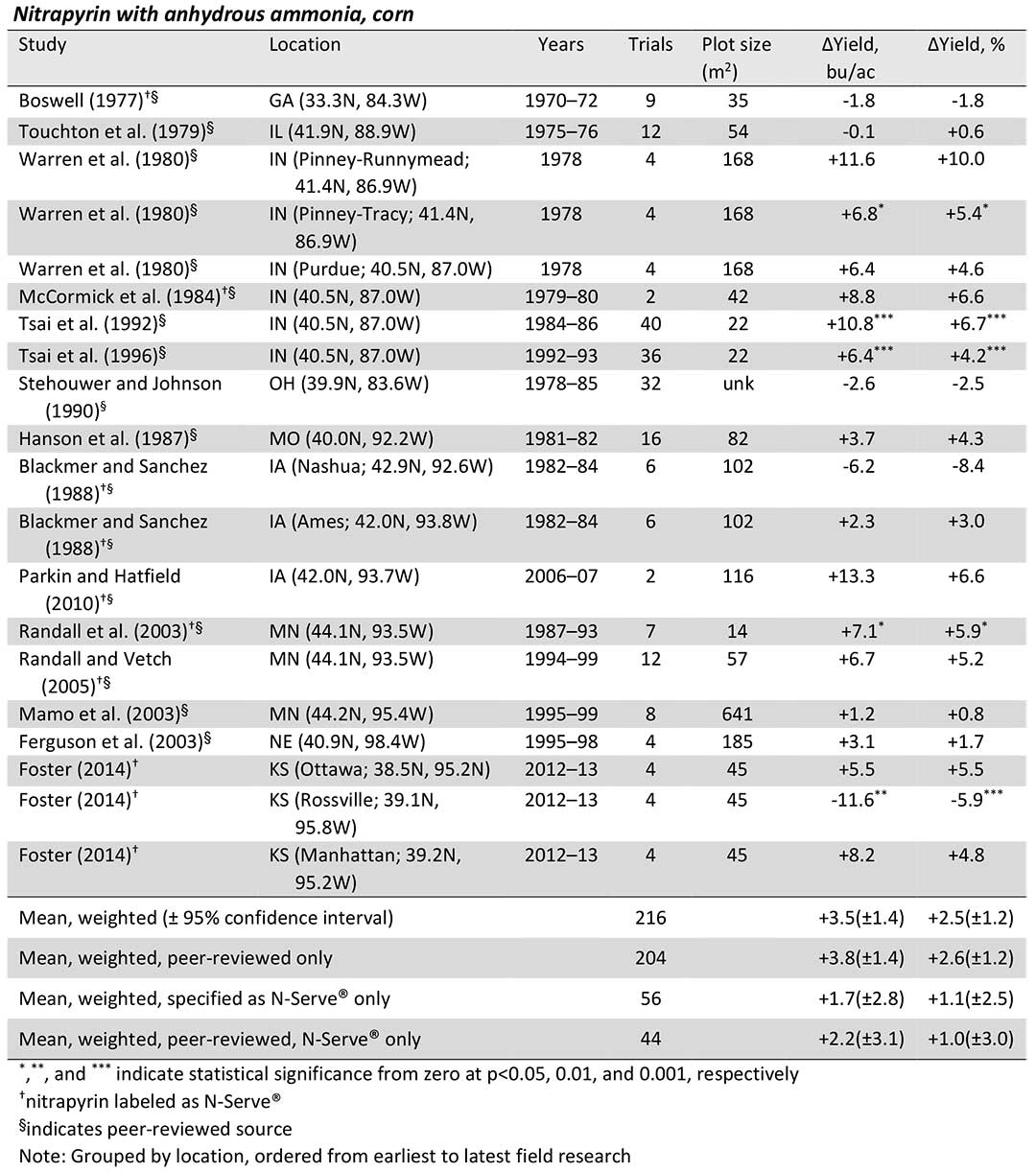
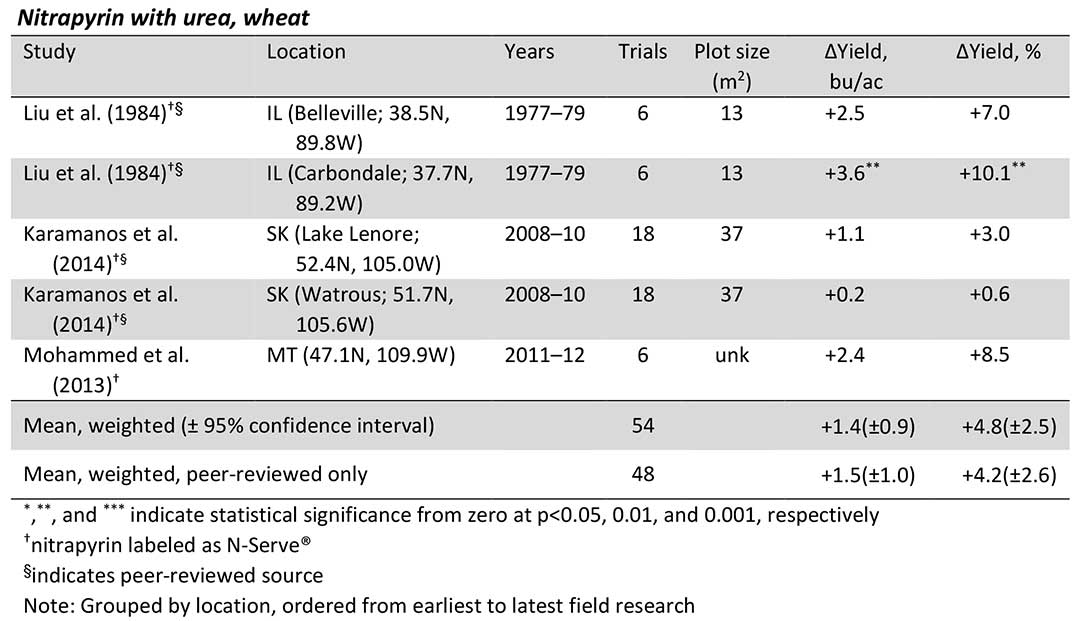
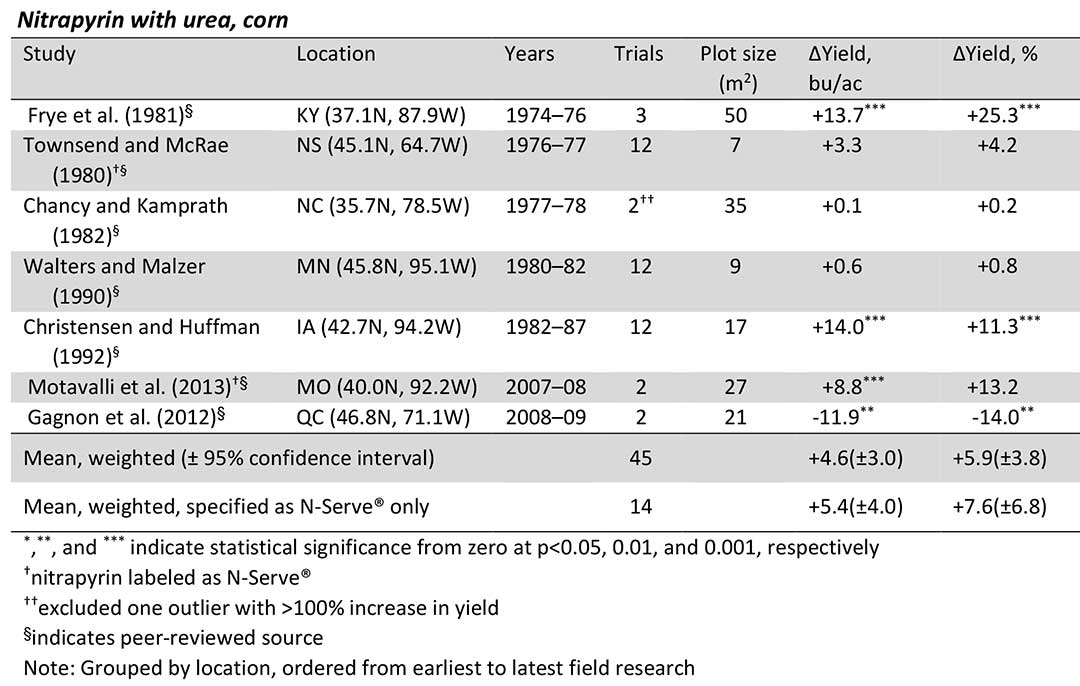
Nitrapyrin applied with either anhydrous ammonia or urea has a long history of field trials, especially with corn. For both anhydrous ammonia and urea, all wheat experiments reported using N-Serve®, but for corn experiments this was far less common. Results for wheat were consistent across both fertilizer sources, with average yield increases of 4.8% with the nitrification inhibitor. Across a large number of research studies, we see average corn yield increases of over 2% with anhydrous ammonia and almost 6% with urea. Exclusion of data from the grey literature had little impact on overall results. For corn, restricting the analysis to only those studies that reported using the brand-name N-Serve® product seemed to erase the positive effect for anhydrous ammonia. However, the active ingredient (nitrapyrin) is no different among these experiments, and further testing with regression models did not find any yield response difference between N-Serve® and generic nitrapyrin. Therefore, it seems reasonable to look at the full dataset, concluding that there is indeed a positive yield impact when N-Serve® is used with anhydrous ammonia or urea on corn.
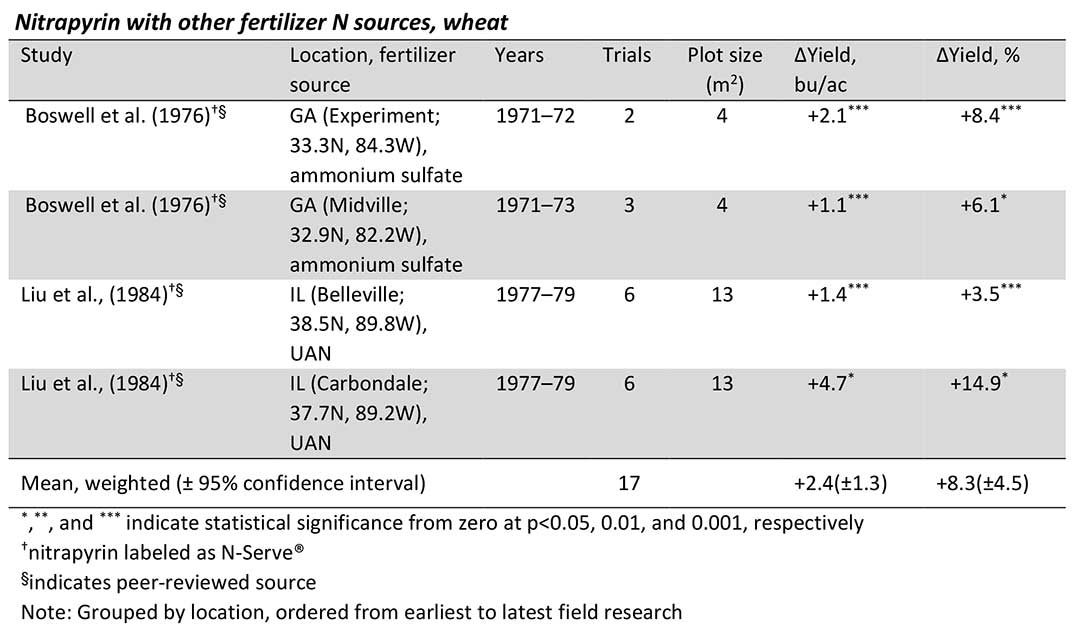
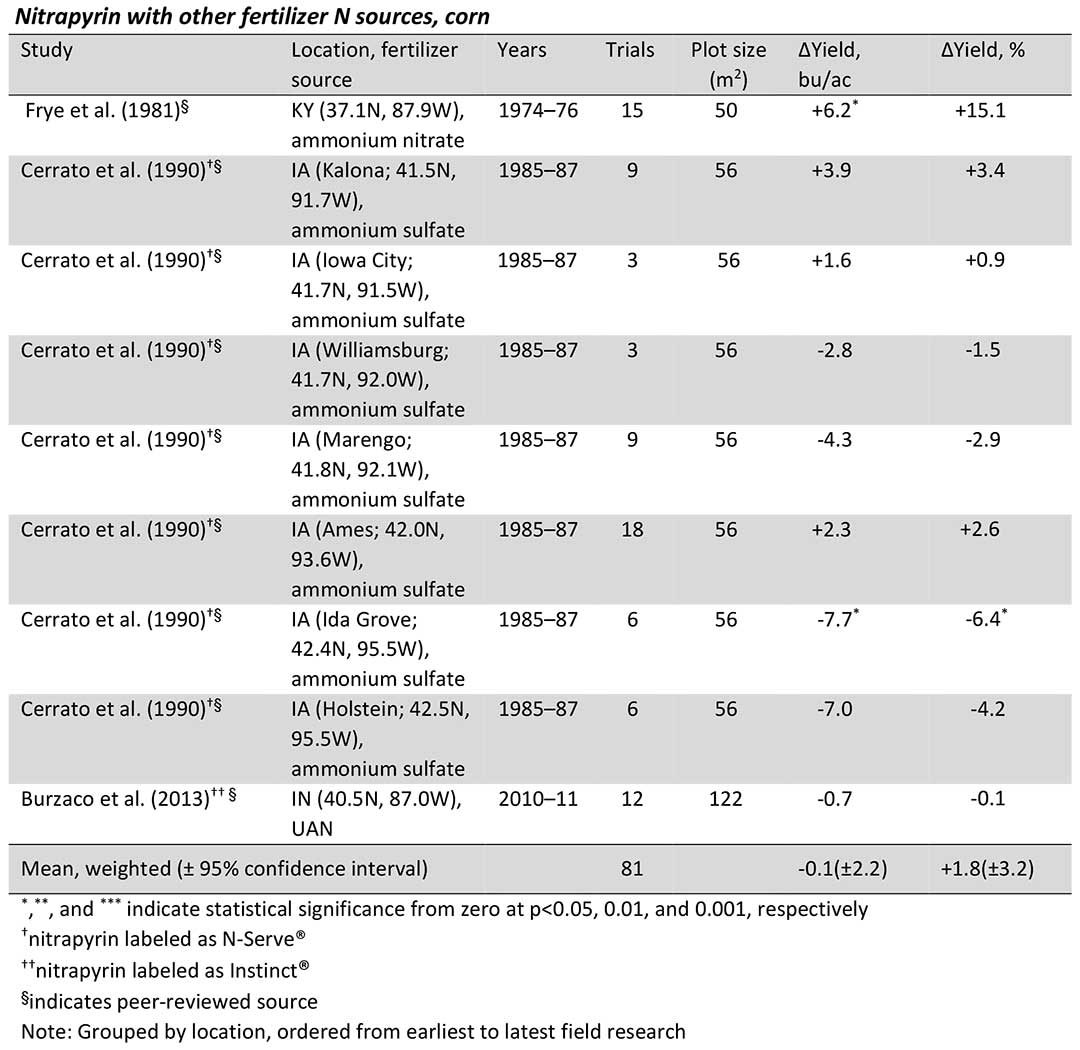
Field researchers have also tested corn yield response to nitrapyrin with other N fertilizers, including UAN, ammonium nitrate, and ammonium sulfate, with insignificant results. On the other hand, wheat yields average 8.3% higher with nitrapyrin for UAN and ammonium sulfate, although these data are limited. Including these “miscellaneous” fertilizer types with the anhydrous ammonia and urea research studies, there is broad regional coverage across much of the U.S. and Canada for nitrapyrin yield experiments (except for the western states).
Putting together all mineral fertilizer sources (anhydrous ammonia, urea, UAN, ammonium nitrate, and ammonium sulfate), nitrapyrin resulted in average corn yield gains of 3.3% (±1.5) and average wheat yield increases of 5.5% (±1.8). Responses seem to be consistent between anhydrous ammonia and urea, and regression models find no significant response differences between these two fertilizer types. Preliminary modeling finds that the responses to nitrapyrin are not affected by tillage, irrigation status, or crop rotation.
While holding fertilizer rate and other management characteristics constant, nitrapyrin treatment increases average grain yield for both corn and wheat in North America. These yield benefits suggest that nitrapyrin increases nitrogen use efficiency, so that it may also be possible to use nitrapyrin and reduce fertilizer N rates while not negatively affecting yield. Such action could reduce environmentally harmful N losses and fertilizer costs.
In addition, studies have found some potential for N loss reduction with nitrapyrin even without changing fertilizer N rates. Researchers in Minnesota tested NO3 leaching losses in corn fertilized with urea, with and without nitrapyrin (12 observations), finding no statistically significant difference in total NO3 losses, but these losses were delayed with nitrapyrin use (Walters and Malzer 1990). Thus, with N available to the plant later in the season, it may be possible to reduce N rates (and leaching losses) while still achieving the same crop yield. Further south, but also in Minnesota, other scientists found that nitrapyrin with anhydrous ammonia reduced total yield-scaled NO3 losses by 13.1% (±9.3; n=18) (Randall and Vetsch 2005; Randall et al. 2003). As these results are limited to one region, it would be prudent to confirm whether such benefits also exist in other climatic and soil conditions. Given its demonstrated ability to increase crop yield while simultaneously decreasing fertilizer N needs as well as damaging N losses to the air and water, nitrapyrin promises to be an important component of improved management practices.
Blackmer, A.M. and C.A. Sanchez. 1988. Response of corn to nitrogen-15-labeled anhydrous ammonia with and without nitrapyrin in Iowa. Agronomy Journal 80(1):95–102.
Boswell, F.C. 1977. Seasonal anhydrous ammonia comparison for corn with and without a nitrification inhibitor. Agronomy Journal 69(1):103–06.
Boswell, F.C., L.R. Nelson and M.J. Bitzer. 1976. Nitrification inhibitor with fall-applied vs split nitrogen applications for winter-wheat. Agronomy Journal 68(5):737–40.
Briggs, G.G. 1975. The behaviour of the nitrification inhibitor “N‐Serve” in broadcast and incorporated applications to soil. Journal of the Science of Food and Agriculture 26(8):1083–92.
Burzaco, J.P., D.R. Smith and T.J. Vyn. 2013. Nitrous oxide emissions in Midwest US maize production vary widely with band-injected N fertilizer rates, timing and nitrapyrin presence. Environmental Research Letters 8(3):035031.
Cerrato, M.E. and A.M. Blackmer. 1990. Effects of nitrapyrin on corn yields and recovery of ammonium-N at 18 site-years in Iowa. Journal of Production Agriculture 3(4):513–21.
Chancy, H.F. and E.J. Kamprath. 1982. Effect of nitrapyrin on N response of corn on sandy soils. Agronomy Journal 74(3):565–69.
Christensen, R.H. and J.R. Huffman. 1992. Response of corn to preplant applications of nitrogen and to nitrogen plus nitrapyrin. Journal of Production Agriculture 5(3):352–58.
Ferguson, R.B., R.M. Lark and G.P. Slater. 2003. Approaches to management zone definition for use of nitrification inhibitors. Soil Science Society of America Journal 67(3):937–47.
Foster, T.J. 2014. The use of nitrogen timing and nitrification inhibitors as tools in corn and wheat production in Kansas. MS Thesis, Kansas State University, Manhattan, KS.
Frye, W.W., R.L. Blevins, L.W. Murdock, K.L. Wells and J.H. Ellis. 1981. Effectiveness of nitrapyrin with surface-applied fertilizer nitrogen in no-tillage corn. Agronomy Journal 73(2):287–89.
Gagnon, B., N. Ziadi and C. Grant. 2012. Urea fertilizer forms affect grain corn yield and nitrogen use efficiency. Canadian Journal of Soil Science 92(2):341–51.
Goring, C.A. 1962. Control of nitrification by 2-chloro-6-(trichloro-methyl) pyridine. Soil Science 93(3):211–18.
Hanson, R.G., S.R. Maledy and C.E. Jentes. 1987. Effect of anhydrous ammonia with and without nitrapyrin applied fall and spring on corn yield. Communications in Soil Science and Plant Analysis 18(4):387–403.
Karamanos, R.E., K. Hanson and F.C. Stevenson. 2014. Nitrogen form, time and rate of application, and nitrification inhibitor effects on crop production. Canadian Journal of Plant Science 94(2):425–32.
Laskowski, D.A., F.C. O’Melia, J.D. Griffith, A.J. Regoli, C.R. Youngson and C.A.I. Goring. 1975. Effect of 2-chloro-6-(trichloromethyl) pyridine and its hydrolysis product 6-chloropicolinic acid on soil microorganisms. Journal of Environmental Quality 4(3):412–17.
Liu, S.L., E.C. Varsa, G. Kapusta and D.N. Mburu. 1984. Effect of etridiazol and nitrapyrin treated N-fertilizers on soil mineral N status and wheat yields. Agronomy Journal 76(2):265–70.
Mamo, M., G.L. Malzer, D.J. Mulla, D.R. Huggins and J. Strock. 2003. Spatial and temporal variation in economically optimum nitrogen rate for corn. Agronomy Journal 95(4):958–64.
McCall, P.J. and R.L. Swann. 1978. Nitrapyrin volatility from soil. Down to Earth 34(3):21-27.
McCormick, R.A., D.W. Nelson, A.L. Sutton and D.M. Huber. 1984. Increased N efficiency from nitrapyrin added to liquid swine manure used as a fertilizer for corn. Agronomy Journal 76(6):1010–14.
Mohammed, Y.A., T. Jensen, J. Heser and C. Chen. 2013. Inhibitors, method and time of nitrogen application for improved winter wheat production in central Montana. In Proceedings of the Western Nutrient Management Conference, Reno, NV.
Motavalli, P.P., K.A. Nelson and S. Bardhan. 2013. Development of a variable-source N fertilizer management strategy using enhanced-efficiency N fertilizers. Soil Science 178(12):693–703.
Nelson, D.W. and D.M. Huber. 1980. Performance of nitrification inhibitors in the Midwest (east), pp. 75–88. In J.J. Meisinger, G.W. Randall and M.L. Vitosh, eds. Nitrification Inhibitors—Potentials and Limitations. American Society of Agronomy and Soil Science Society of America, Madison, WI.
Owens, L.B. 1981. Effects of nitrapyrin on nitrate movement in soil columns. Journal of Environmental Quality 10(3):308–10.
Owens, L.B. 1987. Nitrate leaching losses from monolith lysimeters as influenced by nitrapyrin. Journal of Environmental Quality 16(1):34–38.
Parkin, T.B. and J.L. Hatfield. 2010. Influence of nitrapyrin on N2O losses from soil receiving fall-applied anhydrous ammonia. Agriculture, Ecosystems and Environment 136(1–2):81–86.
Randall, G.W. and J.A. Vetsch. 2005. Corn production on a subsurface-drained mollisol as affected by fall versus spring application of nitrogen and nitrapyrin. Agronomy Journal 97(2):472–78.
Randall, G.W., J.A. Vetsch and J.R. Huffman. 2003. Corn production on a subsurface-drained mollisol as affected by time of nitrogen application and nitrapyrin. Agronomy Journal 95(5):1213–19.
Shattuck, G.E. and M. Alexander. 1963. A differential inhibitor of nitrifying microorganisms. Soil Science Society of America Journal 27(5):600–01.
Stehouwer, R.C. and J.W. Johnson. 1990. Urea and anhydrous ammonia management for conventional tillage corn production. Journal of Production Agriculture 3(4):507–13.
The Dow Chemical Company. 2012. Product Safety Assessment: Nitrapyrin. 6 pp. http://msdssearch.dow.com/PublishedLiteratureDOWCOM/dh_08c1/0901b803808c186f.pdf.
The Dow Chemical Company. 2013a. Instinct® II Nitrogen Stabilizer Fact Sheet. http://msdssearch.dow.com/PublishedLiteratureDAS/dh_08f3/0901b803808f3926.pdf.
The Dow Chemical Company. 2013b. N-Serve® Nitrogen Stabilizer Fact Sheet. http://msdssearch.dow.com/PublishedLiteratureDAS/dh_08f3/0901b803808f3922.pdf.
Timmons, D.R. 1984. Nitrate leaching as influenced by water application level and nitrification inhibitors. Journal of Environmental Quality 13(2):305–09.
Touchton, J.T., R.G. Hoeft, L.F. Welch, D.L. Mulvaney, M.G. Oldham and F.E. Zajicek. 1979. N uptake and corn yield as affected by applications of nitrapyrin with anhydrous ammonia. Agronomy Journal 71(2):238–42.
Townsend, L.R. and K.B. McRae. 1980. The effect of the nitrification inhibitor nitrapyrin on yield and on nitrogen fractions in soil and tissue of corn (Zea-mays-L) grown in the Annapolis valley of Nova Scotia. Canadian Journal of Plant Science 60(2):337–47.
Tsai, C.Y. and D.M. Huber. 1996. Genetic variation of maize hybrids in grain yield response to potassium and inhibiting nitrification. Journal of the Science of Food and Agriculture 70(2):263–70.
Tsai, C.Y., I. Dweikat, D.M. Huber and H.L. Warren. 1992. Interrelationship of nitrogen nutrition with maize (Zea-mays) grain-yield, nitrogen use efficiency and grain quality. Journal of the Science of Food and Agriculture 58(1):1–8.
Walters, D.T. and G.L. Malzer. 1990. Nitrogen management and nitrification inhibitor effects on nitrogen-15 urea: II. Nitrogen leaching and balance. Soil Science Society of America Journal 54(1):122–30.
Warren, H.L., D.M. Huber, C.Y. Tsai and D.W. Nelson. 1980. Effect of nitrapyrin and N-fertilizer on yield and mineral-composition of corn. Agronomy Journal 72(5):729–32.
